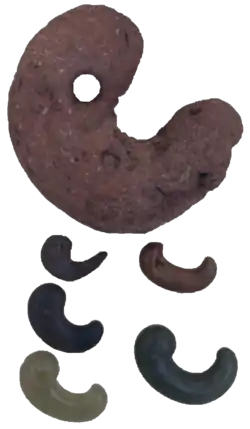まがたま
Japanese
| Alternative spellings |
|---|
| 勾玉 曲玉 |
Etymology
Compound of 曲が (maga, “bent, bending”, appears to be the 未然形 (mizenkei, “incomplete form”) of ancient verb 曲ぐ (magu, “to bend”), root of modern 曲がる (magaru, “to bend”, intransitive), 曲げる (mageru, “to bend something”, transitive)) + 玉 (tama, “jewel”).[1][2]
Noun
まがたま • (magatama)
- a particular kind of curved bead, resembling a bear claw or cashew in shape, usually with a hole piercing the thick end
- These are found in Japanese culture since the prehistoric Jōmon period. See the Wikipedia article for more.
References
- Shōgaku Tosho (1988) 国語大辞典(新装版) [Unabridged Dictionary of Japanese (Revised Edition)] (in Japanese), Tōkyō: Shogakukan, →ISBN
- Matsumura, Akira, editor (2006), 大辞林 [Daijirin] (in Japanese), Third edition, Tōkyō: Sanseidō, →ISBN
This article is issued from Wiktionary. The text is licensed under Creative Commons - Attribution - Sharealike. Additional terms may apply for the media files.
